The Effect of Fine and Coarse Recycled Aggregates on Fresh and Mechanical Properties of Self-Compacting Concrete
Abstract
1. Introduction
2. Research Significance
3. Experimental Design and Materials
3.1. Materials and Mix Proportions
3.2. Mix Properties and Procedure
3.3. Test Program and Procedures
3.3.1. Slump Flow and J-Ring
3.3.2. Compressive and Splitting Tensile Strength Testes
3.3.3. The Stress-strain Relationship
4. Test Results and Discussion
4.1. Fresh Concrete Results
4.2. Properties of Hardened Concrete
4.2.1. Compressive Strength
4.2.2. Splitting Tensile Strength
4.2.3. Compressive Stress-strain Behavior
5. Conclusions
- (1)
- Utilization of recycled aggregates reduced the slump flow, but the use of higher amounts of superplasticizer could prevent reduction of slump flow. Also, the use of recycled aggregates in self-compacting recycled concrete showed acceptable passing ability in the J-ring test.
- (2)
- Replacement of recycled aggregates in the mixtures including air-entraining admixture reduced compressive strength. However, no significant reduction of splitting tensile strength was observed.
- (3)
- Replacement of 100% coarse recycled concrete aggregates did not affect the compressive and tensile strength of the silica fume mixtures. Where the fine recycled aggregate negatively affected the compressive strength and tensile strength of the RAC ones.
- (4)
- The recycled aggregates in concretes containing air-entrained admixture cause a decrease in compressive strength and modulus of elasticity. Substitution of 100% coarse RCA in silica fume specimens had no significant effect on the shape of the stress-strain curve, but the fine recycled aggregates caused a decrease in the energy absorption and compressive strength of the specimens.
- (5)
- Crack inspection of the recycled specimens after compressive strength testing showed vertical cracks which revealed the failure of the recycled aggregate. Introducing silica fume into the recycled specimens changed the inclined crack pattern with an angle of approximately 45° and similar to those for the crack patterns of the reference samples.
- (6)
- The present obtained results regarding utilization of RCA, as a partial replacement for natural aggregates, may lead to the fact that recycled aggregate concrete is an environmentally friendly material.
Author Contributions
Funding
Conflicts of Interest
References
- Aslani, F.; Ma, G.; Yim Wan, D.L.; Muselin, G. Development of high-performance self-compacting concrete using waste recycled concrete aggregates and rubber granules. J. Clean. Prod. 2018, 182, 553–566. [Google Scholar] [CrossRef]
- Tam, V.W.Y.; Soomro, M.; Evangelista, A.C.J. A review of recycled aggregate in concrete applications (2000–2017). Constr. Build. Mater. 2018, 172, 272–292. [Google Scholar] [CrossRef]
- Sorato, R. Recycled Aggregate Concrete; an Overview. Bachelor’s Thesis, Helsinki Metropolia University, Helsinki, Finland, 2016. [Google Scholar]
- Liu, M. Self-compacting concrete with different levels of pulverized fuel ash. Constr. Build. Mater. 2010, 24, 1245–1252. [Google Scholar] [CrossRef]
- Leemann, A.; Loser, R.; Münch, B. Influence of cement type on ITZ porosity and chloride resistance of self-compacting concrete. Cem. Concr. Compos. 2010, 32, 116–120. [Google Scholar] [CrossRef]
- Filho, F.A.; Barragán, B.; Casas, J.; El Debs, A.; Casas, J.; El Debs, A.L. Hardened properties of self-compacting concrete—A statistical approach. Constr. Build. Mater. 2010, 24, 1608–1615. [Google Scholar] [CrossRef]
- Loukili, A. Self-Compacting Concrete; John Wiley & Sons, Inc.: Hoboken, NJ, USA, 2011. [Google Scholar]
- Şahmaran, M.; Christianto, H.A.; Yaman İ, Ö. The effect of chemical admixtures and mineral additives on the properties of self-compacting mortars. Cem. Concr. Compos. 2006, 28, 432–440. [Google Scholar] [CrossRef]
- De Juan, M.S.; Gutiérrez, P.A. Study on the influence of attached mortar content on the properties of recycled concrete aggregate. Constr. Build. Mater. 2009, 23, 872–877. [Google Scholar] [CrossRef]
- González-Fonteboa, B.; Martínez-Abella, F.; Eiras-López, J.; Seara-Paz, S. Effect of recycled coarse aggregate on damage of recycled concrete. Mater. Struct. Constr. 2011, 44, 1759. [Google Scholar] [CrossRef]
- Corinaldesi, V. Structural concrete prepared with coarse recycled concrete aggregate: from investigation to design. Adv. Civ. Eng. 2011, 2011, 283984. [Google Scholar] [CrossRef]
- Etxeberria, M.; Vázquez, E.; Mari, A.; Barra, M. Influence of amount of recycled coarse aggregates and production process on properties of recycled aggregate concrete. Cem. Concr. Res. 2007, 37, 735–742. [Google Scholar] [CrossRef]
- Rahal, K. Mechanical properties of concrete with recycled coarse aggregate. Build. Environ. 2007, 42, 407–415. [Google Scholar] [CrossRef]
- Li, J.; Xiao, H.; Zhou, Y. Influence of coating recycled aggregate surface with pozzolanic powder on properties of recycled aggregate concrete. Constr. Build. Mater. 2009, 23, 1287–1291. [Google Scholar] [CrossRef]
- Alengaram, U.J.; Salam, A.; Jumaat, M.Z.; Jaafar, F.F.; Saad, H.B. Properties of high-workability concrete with recycled concrete aggregate. Mater. Res. 2011, 14, 248–255. [Google Scholar]
- Gómez-Soberón, J.M.V. Porosity of recycled concrete with substitution of recycled concrete aggregate: An experimental study. Cem. Concr. Res. 2002, 32, 1301–1311. [Google Scholar] [CrossRef]
- Limbachiya, M.C.; Koulouris, A.; Roberts, J.J.; Fried, A.N. Performance of recycled aggregate concrete. In Proceedings of the RILEM International Symposium on Environment-Conscious Materials and Systems for Sustainable Development, Koriyama, Japan, 6–7 September 2004. [Google Scholar]
- Limbachiya, M.; Meddah, M.S.; Ouchagour, Y. Use of recycled concrete aggregate in fly-ash concrete. Constr. Build. Mater. 2012, 27, 439–449. [Google Scholar] [CrossRef]
- Rao, M.; Bhattacharyya, S.K.; Barai, S.V. Influence of field recycled coarse aggregate on properties of concrete. Mater. Struct. Constr. 2011, 44, 205–220. [Google Scholar]
- Yang, J.; Du, Q.; Bao, Y. Concrete with recycled concrete aggregate and crushed clay bricks. Constr. Build. Mater. 2011, 25, 1935–1945. [Google Scholar] [CrossRef]
- Dhir, R.K.; Limbachiya, M.C.; Leelawat, T. Suitability of recycled concrete aggregate for use in BS 5328 designated mixes. Proc. Inst. Civ. Eng. -Struct. Build. 1999, 134, 257–274. [Google Scholar] [CrossRef]
- De Brito, J.; Saikia, N. Recycled Aggregate in Concrete Use of Industrial, Construction and Demolition Waste; Springer: Berlin/Heidelberg, Germany, 2013; ISBN 9781447145394. [Google Scholar]
- Buyle-Bodin, F.; Hadjieva-Zaharieva, R. Influence of industrially produced recycled aggregates on flow properties of concrete. Mater. Struct. 2002, 35, 504–509. [Google Scholar] [CrossRef]
- Sagoe-Crentsil, K.; Brown, T.; Taylor, A. Performance of concrete made with commercially produced coarse recycled concrete aggregate. Cem. Concr. Res. 2001, 31, 707–712. [Google Scholar] [CrossRef]
- Vieira, J.P.B.; Correia, J.R.; Brito, J. De Cement and Concrete Research Post-fire residual mechanical properties of concrete made with recycled concrete coarse aggregates. Cem. Concr. Res. 2011, 41, 533–541. [Google Scholar] [CrossRef]
- Corinaldesi, V.; Moriconi, G. The role of industrial by-products in self-compacting concrete. Constr. Build. Mater. 2011, 25, 3181–3186. [Google Scholar] [CrossRef]
- De Brito, J.; Robles, R. Recycled aggregate concrete (RAC) methodology for estimating its long-term properties. Indian J. Eng. Mater. Sci. 2010, 17, 449–462. [Google Scholar]
- Kou, S.-C.; Poon, C.-S. Mechanical properties of 5-year-old concrete prepared with recycled aggregates obtained from three different sources. Mag. Concr. Res. 2008, 60, 57–64. [Google Scholar] [CrossRef]
- Ravindrarajah, R.S.; Loo, Y.H.; Tam, C.T. Recycled concrete as fine and coarse aggregates in concrete. Mag. Concr. Res. 1987, 39, 214–220. [Google Scholar] [CrossRef]
- Belén, G.-F.; Fernando, M.-A.; Diego, C.L.; Sindy, S.-P. Stress-strain relationship in axial compression for concrete using recycled saturated coarse aggregate. Constr. Build. Mater. 2011, 25, 2335–2342. [Google Scholar] [CrossRef]
- Shi, C.; Li, Y.; Zhang, J.; Li, W.; Chong, L.; Xie, Z. Performance enhancement of recycled concrete aggregate—A review. J. Clean. Prod. 2016, 112, 466–472. [Google Scholar] [CrossRef]
- Tam, V.W.; Tam, C.M. Diversifying two-stage mixing approach (TSMA) for recycled aggregate concrete: TSMAs and TSMAsc. Constr. Build. Mater. 2008, 22, 2068–2077. [Google Scholar] [CrossRef]
- EFNARC. Specification and Guidelines for Self-Compacting Concrete; EFNARC: Surrey, UK, 2002. [Google Scholar]
- Nili, M.; Ghorbankhani, A.; Alavinia, A.; Zolfaghari, M. Assessing the impact strength of steel fibre-reinforced concrete under quasi-static and high velocity dynamic impacts. Constr. Build. Mater. 2016, 107, 264–271. [Google Scholar] [CrossRef]
- Grdic, Z.J.; Toplicic-Curcic, G.A.; Despotovic, I.M.; Ristic, N.S. Properties of self-compacting concrete prepared with coarse recycled concrete aggregate. Constr. Build. Mater. 2010, 24, 1129–1133. [Google Scholar] [CrossRef]
- Fakitsas, C.G.; Papakonstantinou, P.E.A.; Kiousis, P.D.; Savva, A. Effects of Recycled Concrete Aggregates on the Compressive and Shear Strength of High-Strength Self-Consolidating Concrete. J. Mater. Civ. Eng. 2012, 24, 356–361. [Google Scholar] [CrossRef]
- Zhou, C.; Chen, Z. Mechanical properties of recycled concrete made with different types of coarse aggregate. Constr. Build. Mater. 2017, 134, 497–506. [Google Scholar] [CrossRef]
- Dimitriou, G.; Savva, P.; Petrou, M.F. Enhancing mechanical and durability properties of recycled aggregate concrete. Constr. Build. Mater. 2018, 158, 228–235. [Google Scholar] [CrossRef]
- BS EN 1097-6:2013. Tests for Mechanical and Physical Properties of Aggregates—Determination of Particle Density and Water Absorption; BSI: London, UK, 2013. [Google Scholar]
- Kwan, W.H.; Ramli, M.; Kam, K.J.; Sulieman, M.Z. Influence of the amount of recycled coarse aggregate in concrete design and durability properties. Constr. Build. Mater. 2012, 26, 565–573. [Google Scholar] [CrossRef]
- Corinaldesi, V.; Moriconi, G. Influence of mineral additions on the performance of 100% recycled aggregate concrete. Constr. Build. Mater. 2009, 23, 2869–2876. [Google Scholar] [CrossRef]
- Çakır, O.; Aköz, F. Effect of curing conditions on the mortars with and without GGBFS. Constr. Build. Mater. 2008, 22, 308–314. [Google Scholar] [CrossRef]
- Maier, P.L.; Durham, S.A. Beneficial use of recycled materials in concrete mixtures. Constr. Build. Mater. 2012, 29, 428–437. [Google Scholar] [CrossRef]
- Kou, S.C.; Poon, C.S. Properties of self-compacting concrete prepared with coarse and fine recycled concrete aggregates. Cem. Concr. Compos. 2009, 31, 622–627. [Google Scholar] [CrossRef]
- Tuyan, M.; Mardani-aghabaglou, A.; Ramyar, K. Freeze-thaw resistance, mechanical and transport properties of self-consolidating concrete incorporating coarse recycled concrete aggregate. Mater. Des. 2014, 53, 983–991. [Google Scholar] [CrossRef]
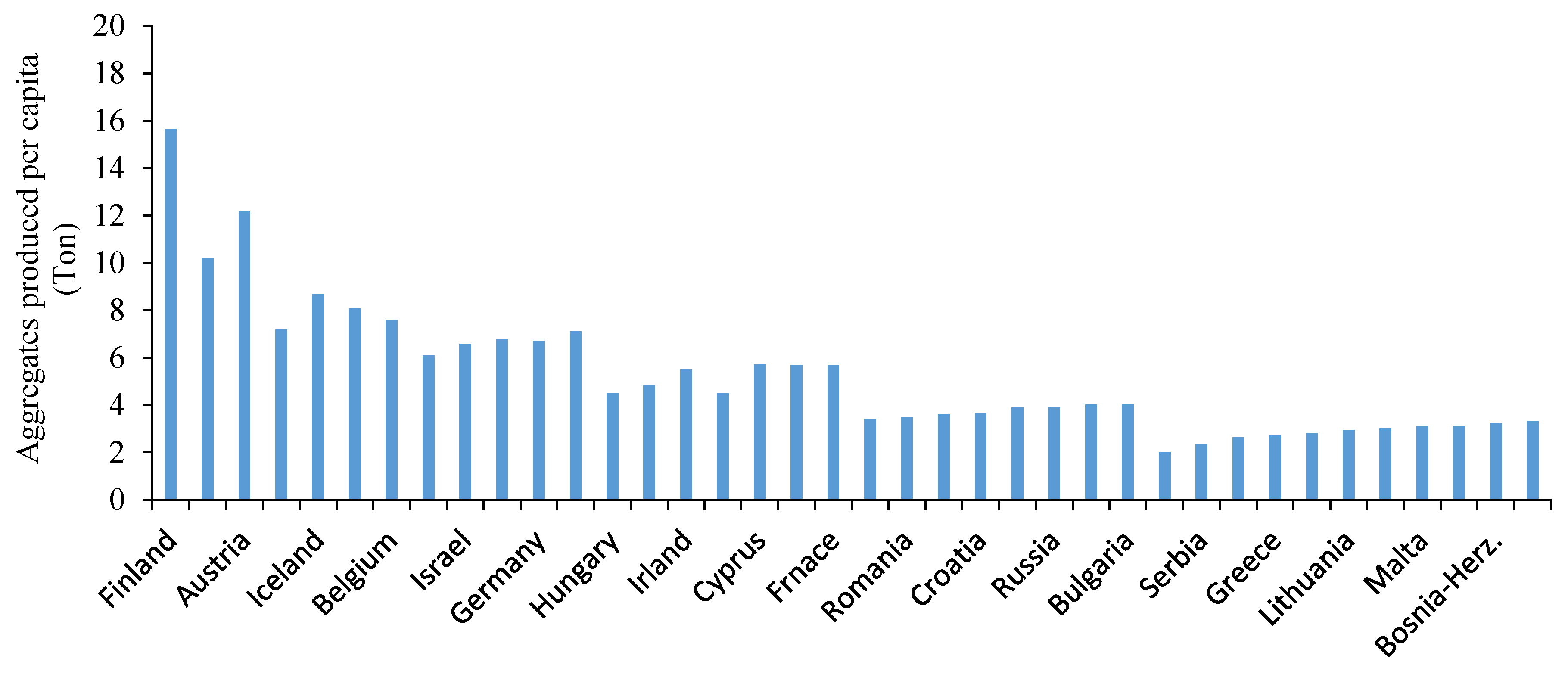

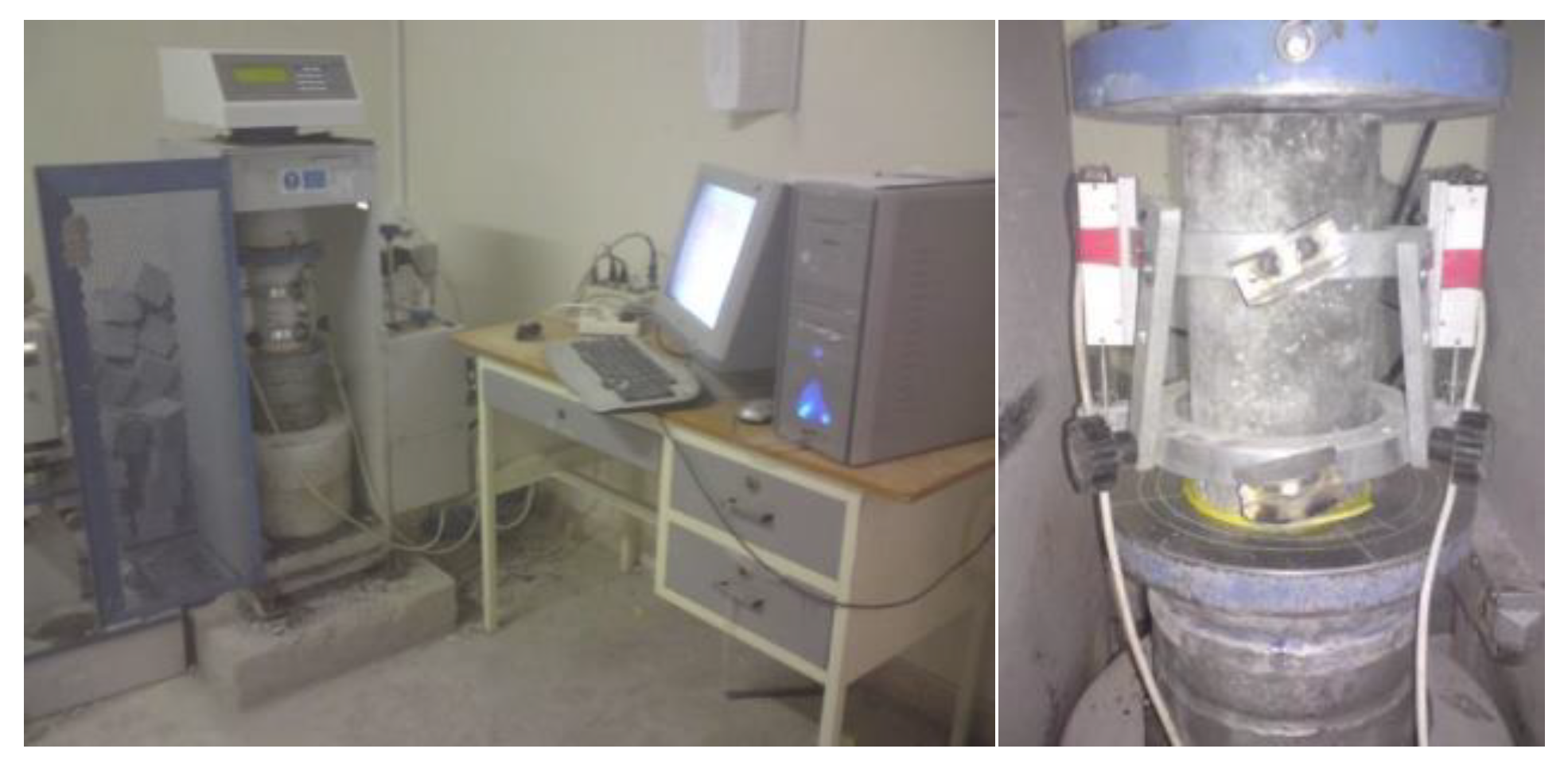

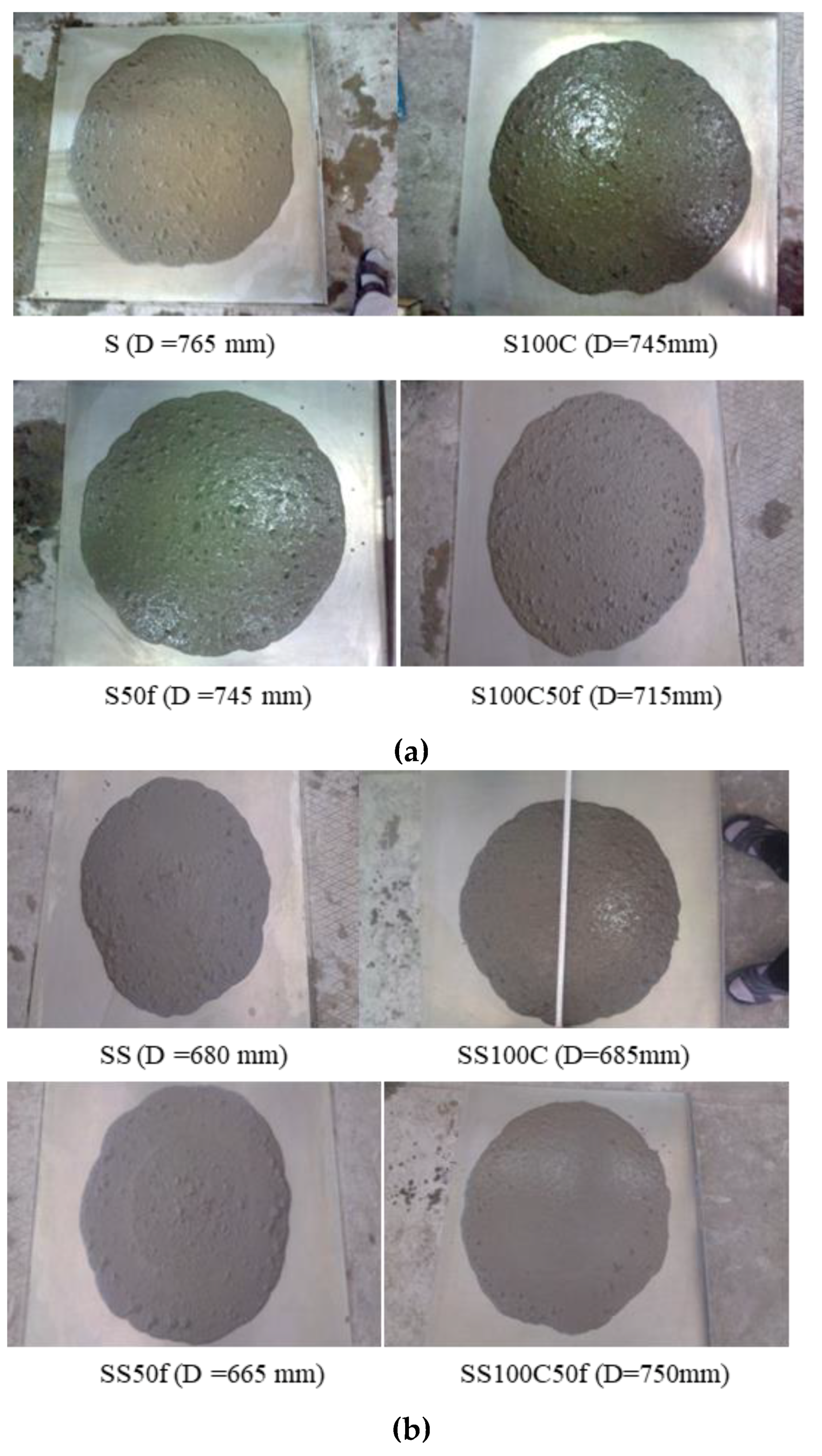
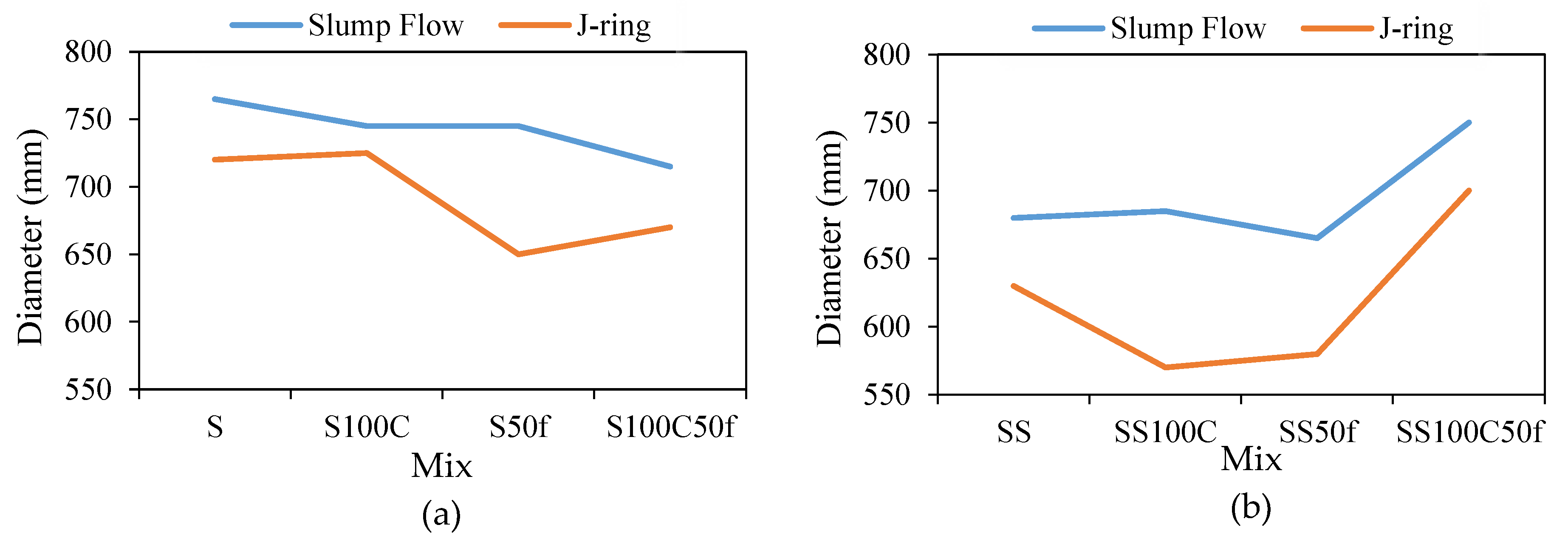

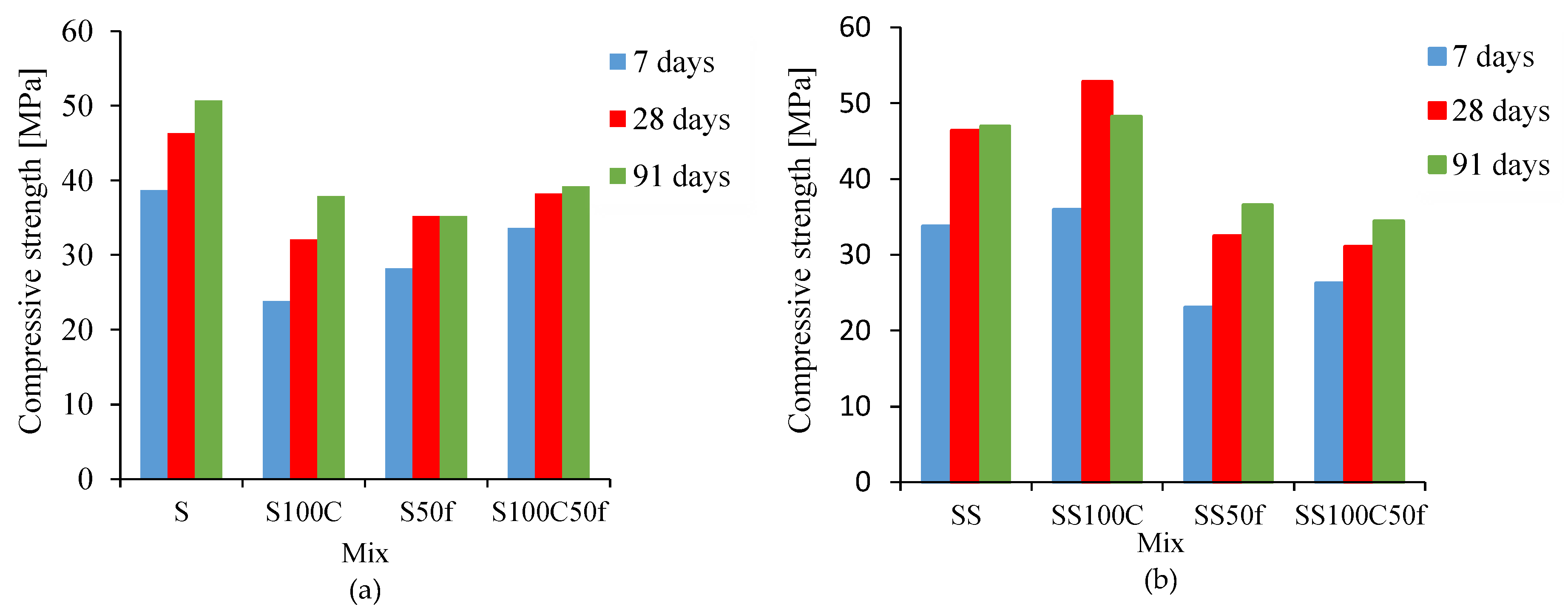

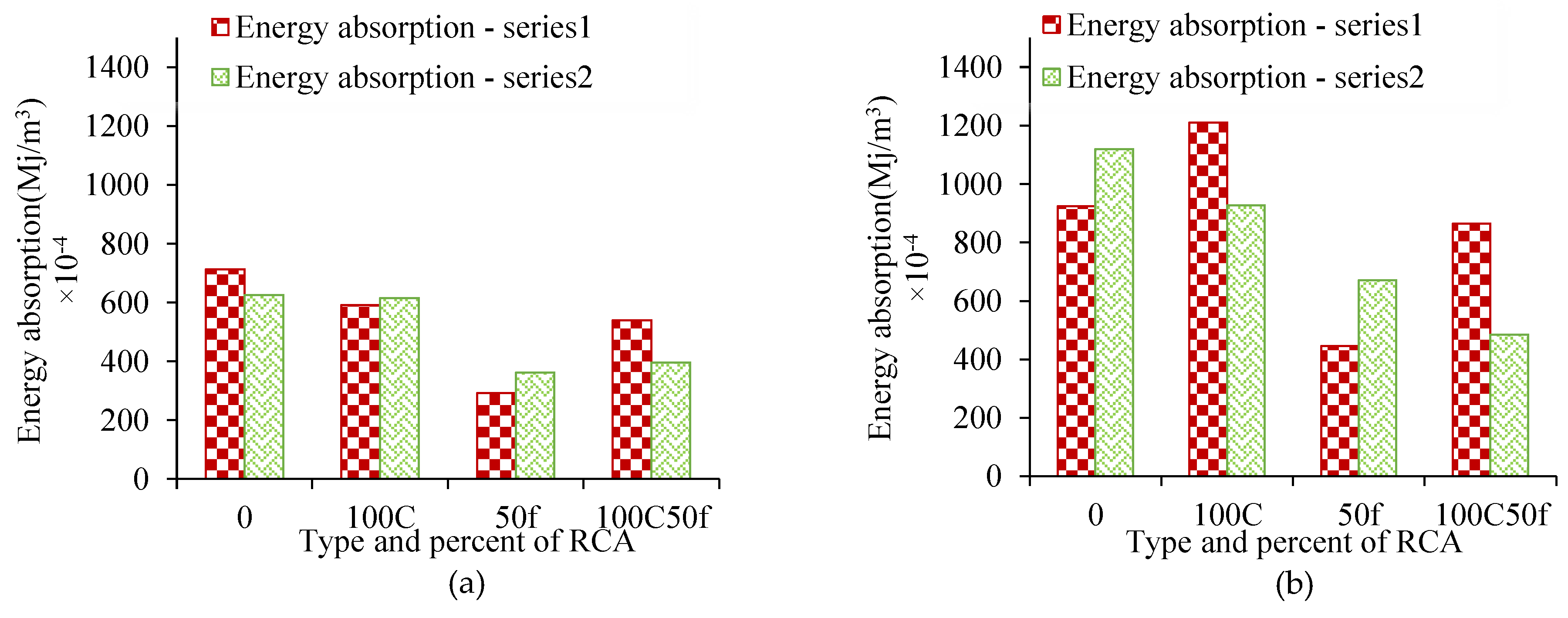
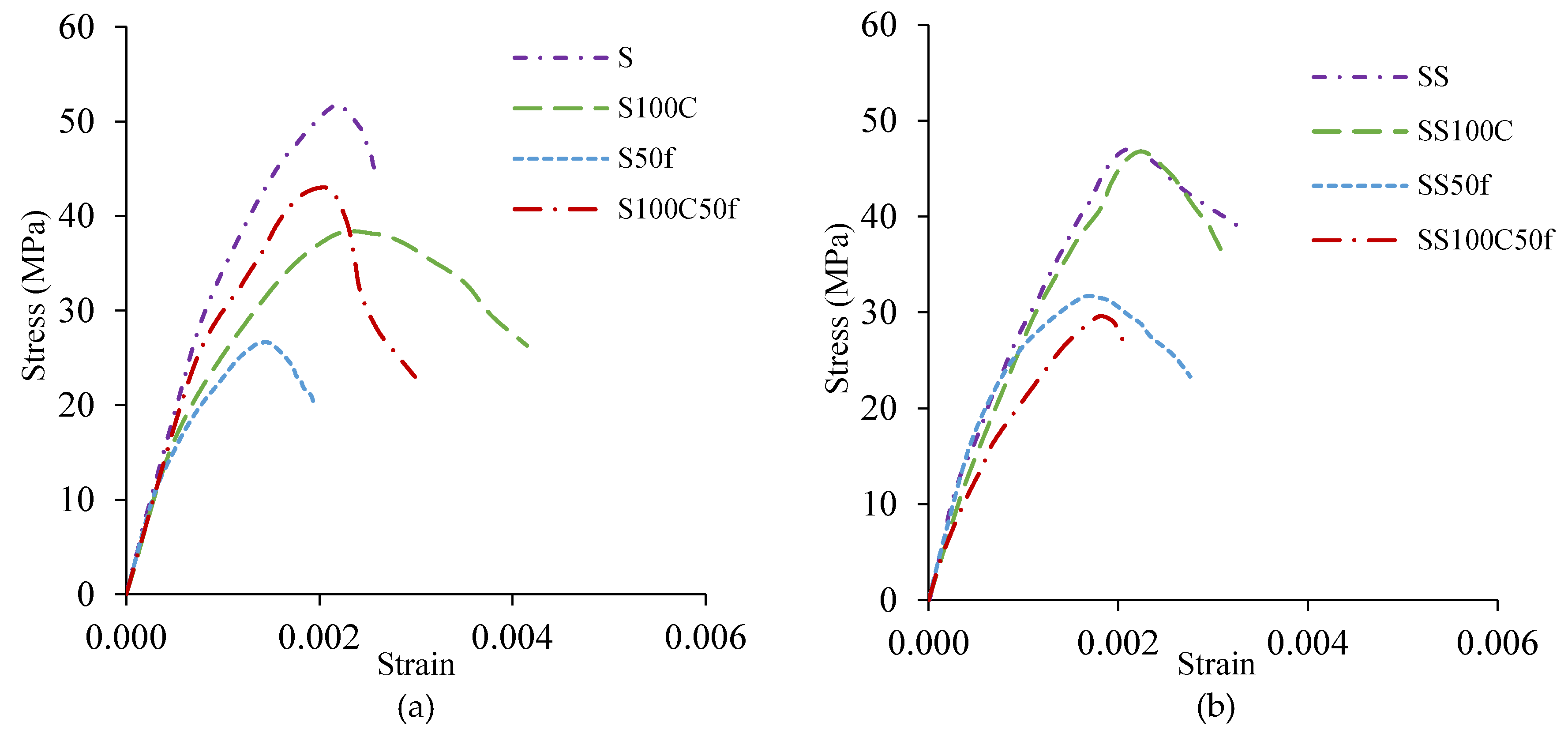

| Type of Aggregate | Specific Gravity (g/cm3) | Maximum Size (mm) | Fineness Modulus | Water Absorption (%) | Los Angeles Abrasion (%) | Adhered Mortar (%) | |
|---|---|---|---|---|---|---|---|
| Coarse | Natural | 2.66 | 19 | - | 1.21 | 13.9 | - |
| RCA | 2.52 | 19 | - | 5.04 | 35.9 | 32.15 | |
| Fine | Natural | 2.53 | - | 3.79 | 3.70 | - | - |
| RCA | 2.46 | - | 3.76 | 7.76 | - | - | |
| Mix Code | Series | W/(C + Sf) | W | Cement | Sf | FNA. | CNA. | FRA. | CRA | LP | SP (%) | AEA (%) |
|---|---|---|---|---|---|---|---|---|---|---|---|---|
| (kg/m3) | ||||||||||||
| S | I | 0.44 | 418 | - | 1172 | 335 | - | - | 167 | 0.8 | - | |
| S100C | - | 1160 | - | - | 331 | 166 | 0.9 | 0.03 | ||||
| S50f | - | 580 | 332 | 580 | - | 166 | 0.9 | 0.03 | ||||
| S100C50f | - | 574 | - | 574 | 328 | 164 | 0.9 | 0.03 | ||||
| SS | II | 0.44 | 385 | 33 | 1172 | 335 | - | - | 167 | 0.9 | - | |
| SS100C | 33 | 1160 | - | - | 331 | 166 | 1.0 | - | ||||
| SS50f | 33 | 580 | 332 | 580 | - | 166 | 1.1 | - | ||||
| SS100C50f | 33 | 574 | - | 574 | 328 | 164 | 1.2 | - | ||||
| Mix Code | Series | Sp (%) | Slump Flow (mm) | T50 (s) | T Final (s) | J-ring (mm) | J-ring Height Difference (mm) | Whether Conforms to EFNARC [33] Guidelines? |
|---|---|---|---|---|---|---|---|---|
| S | I | 0.8 | 765 | 3 | 31 | 720 | 9 | Yes |
| S100C | 0.9 | 745 | 3 | 32 | 725 | 2 | Yes | |
| S50f | 0.9 | 745 | 2 | 33 | 650 | 5 | Yes | |
| S100C50f | 0.9 | 715 | 4 | 55 | 670 | 8 | Yes | |
| SS | II | 0.9 | 680 | 2 | 19 | 630 | 5 | Yes |
| SS100C | 1 | 685 | 2 | 23 | 570 | 3 | Yes | |
| SS50f | 1.1 | 665 | 3 | 25 | 580 | 5 | Yes | |
| SS100C50f | 1.2 | 750 | 2 | 37 | 700 | 2 | Yes |
| Mix Code | Series | Compressive Strength (MPa) | Splitting Tensile Strength (MPa) | ||
|---|---|---|---|---|---|
| 7 Days | 28 Days | 91 Days | 28 Days | ||
| S | I | 46.3 | 50.7 | 3.4 | |
| S100C | 32.1 | 37.9 | 3.4 | ||
| S50f | 35.2 | 35.2 | 3.2 | ||
| S100C50f | 38.2 | 39.2 | 3.4 | ||
| SS | II | 46.4 | 47 | 4.3 | |
| SS100C | 52.9 | 48.3 | 4.1 | ||
| SS50f | 32.5 | 36.6 | 2.9 | ||
| SS100C50f | 31.8 | 34.5 | 3.1 | ||
| Mix Code | Series | Energy Absorption × 10−4(MJ/m3) | Energy Absorption × 10−4 (MJ/m3) | Modulus of Elasticity (GPa) | ||
|---|---|---|---|---|---|---|
| S | I | 2.18 | 713 | 2.61 | 924 | 38.8 |
| S100C | 2.33 | 591 | 4.17 | 1210 | 33.3 | |
| S50f | 1.69 | 292 | 2.33 | 446 | 30.3 | |
| S100C50f | 2 | 540 | 3 | 865 | 34.9 | |
| SS | II | 2.18 | 626 | 3.34 | 1120 | 32.3 |
| SS100C | 2.23 | 615 | 3.09 | 928 | 29.1 | |
| SS50f | 1.68 | 362 | 2.77 | 671 | 39.8 | |
| SS100C50f | 2.17 | 396 | 2.48 | 485 | 21.4 |
© 2019 by the authors. Licensee MDPI, Basel, Switzerland. This article is an open access article distributed under the terms and conditions of the Creative Commons Attribution (CC BY) license (http://creativecommons.org/licenses/by/4.0/).
Share and Cite
Nili, M.; Sasanipour, H.; Aslani, F. The Effect of Fine and Coarse Recycled Aggregates on Fresh and Mechanical Properties of Self-Compacting Concrete. Materials 2019, 12, 1120. https://doi.org/10.3390/ma12071120
Nili M, Sasanipour H, Aslani F. The Effect of Fine and Coarse Recycled Aggregates on Fresh and Mechanical Properties of Self-Compacting Concrete. Materials. 2019; 12(7):1120. https://doi.org/10.3390/ma12071120
Chicago/Turabian StyleNili, Mahmoud, Hossein Sasanipour, and Farhad Aslani. 2019. "The Effect of Fine and Coarse Recycled Aggregates on Fresh and Mechanical Properties of Self-Compacting Concrete" Materials 12, no. 7: 1120. https://doi.org/10.3390/ma12071120
APA StyleNili, M., Sasanipour, H., & Aslani, F. (2019). The Effect of Fine and Coarse Recycled Aggregates on Fresh and Mechanical Properties of Self-Compacting Concrete. Materials, 12(7), 1120. https://doi.org/10.3390/ma12071120







